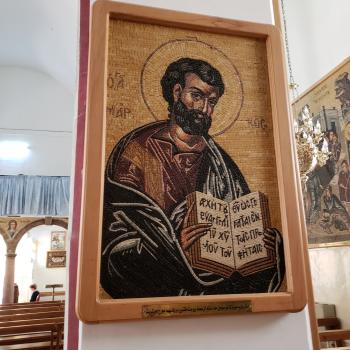Here’s another helpful post by Larry Hurtado…..
In earlier postings I’ve noted that major variants continue to appear, and in some cases “succeed” in gaining widespread acceptance in the subsequent manuscript tradition as late as the fifth century and thereafter. There are also examples of interesting variants that first appear in the extant Greek manuscripts that late, but didn’t “succeed”. Having done my PhD thesis on the text of the Gospel of Mark in Coldex W (the Freer Gospel codex), I’ll cite a few interesting variants in this manuscript as examples.[1]
I’ll begin with a variant that is more well known, the so-called “Freer Logion.” This variant appears only in Codex W among extant Greek manuscripts after what we know as Mark 16:14 (in the “long ending” variant). Here is an English translation:
And they excused themselves, saying, “This age of lawlessness and unbelief is under Satan, who does not allow the truth and power of God to prevail over the unclean things of the spirits [or, does not allow what lies under the unclean spirits to understand the truth and power of God.] Therefore reveal your justice now”— thus they spoke to Christ. And Christ replied to them, “The term of years of Satan’s power has been fulfilled, but other terrible things draw near. And for those who have sinned I was delivered over to death, that they may return to the truth and sin no more, in order that they may inherit the spiritual and incorruptible glory of justice which is in heaven.”[2]
A version of this variant is attested as known to Jerome in some Greek manuscripts in the fourth century.[3] But Codex W is the only extant example. Metzger opined that the logion was probably first added to the text of the “long ending” of Mark by a “scribe” sometime in the second or third century “to soften the severe condemnation of the Eleven in 16.14.”[4] The ascription of the motive for the variant seems cogent, but, as with other “intentional” variants, we should more plausibly ascribe the Freer Logion to some unknown reader/user of a copy of the Gospel of Mark.[5] But my main point is that, whatever its point of origin, this variant didn’t “succeed” in being accepted into the manuscript tradition of Mark beyond Codex W.
A far less well-known variant in the text of Mark in Codex W appears at Mark 1:3. Whereas the best-attested text in vv. 2-3 is a slightly variant quotation of Exodus 23:20 and Isaiah 40:3, in Codex W the quotation of Isaiah includes the whole of 40:3-8. Again, Codex W is the only witness in the Greek manuscript tradition for this variant. And again I think it likely that the variant arose in the course of someone reading the text and adding the words of Isaiah 40:4-8, perhaps originally as a marginal note. In any case, this is another variant of significant size that just didn’t “succeed”.
I cite now a third instance of a variant apparently unique to Codex W. This one is much smaller, but I judge it clearly intentional. I’ll have to set the scene in Mark where the variant appears. In Mark 3:21, the best attested text refers to Jesus’ “associates/friends” or (more likely here) his “relatives” (Greek: οι παρ’ αυτου) setting out to take Jesus in hand for they (or others?) judged him to have lost his senses (Greek: ελεγον γαρ οτι εξεστη).[6] In Codex W (and also Codex Bezae), however, those who sought to take Jesus in hand in v. 21 are “those around him, the scribes and the others” (Greek: ακουσαντες [οτε ακουσαν Codex D] περι αυτου οι γραμματεις και οι λοιποι). Note that this shared variant involved “correcting” the preposition, changing παρα to περι, and disambiguating the text further by specifying “those around him” as “scribes and the others.” The effect (and the purpose) of this variant was clearly to avoid (“correct”) the idea that Jesus’ family could have regarded him as needing to be seized.
But in Codex W there is a further, and apparently distinctive, variant.[7] In place of the report that some were saying Jesus had lost his senses (εξεστη), Codex W has “they were saying ‘he has made them his adherents’.”[8] This actually involved another minor change of two words. Instead of εξεστη (“he is beside himself”), Codex W has εξηρτηνται αυτου, which means something like “they have become his adherents.” The effect (and the purpose) was to avoid the suggestion that Jesus was thought by some to have become somewhat unhinged. It seems to me likely that an early reader of the passage, troubled by what the more familiar wording says, and thinking that it must be some mistake, sought to put things right. Note that this involved replacing εξεστη (exestē) with a word that has a slight phonetic similarity, εξηρτηνται (exērtēntai).
It’s pretty obvious that both of the variants in Codex W (the one shared with Codex Bezae and the one unique to Codex W) were motivated by a pious desire to avoid what seemed to some readers an embarrassing passage that could reflect badly either on Jesus’ family or Jesus himself.[9] So it’s all the more interesting that neither one “succeeded” in getting adopted into the subsequent textual tradition. Instead, the potentially “embarrassing” text was preferred! In short, if the variants in Codex Bezae and Codex W are examples of an attempt at what Ehrman colourfully termed “orthodox corruption” of Mark, the attempts failed, and what is likely the originating form of the text was preferred and preserved.
These interesting variants in Codex W illustrate both the creation of variants, likely by devout readers seeking to amplify (as in the variant in Mark 1:3) and/or to correct the text (as in the “Freer Logion” and the variants in Mark 3:21), and also that such attempts didn’t by any means always “succeed” in the subsequent manuscript tradition. As I’ve emphasized repeatedly, the forces that generated such variants and that made for either their subsequent adoption or rejection deserve more attention.
[1] A lightly revised version of my 1973 PhD thesis was published later: Larry W. Hurtado, Text-Critical Methodology and the Pre-Caesarean Text: Codex W in the Gospel of Mark (“Studies and Documents,” 43; Grand Rapids: Eerdmans, 1981).
[2] Translation from Bruce Metzger, A Textual Commentary on the Greek New Testament, Second Edition (Stuttgart: Deutsche Bibelgesellschaft, 1994), 104. The Greek text (adapted slightly from the Nestle-Aland 28th edition apparatus): κακεινοι απελογουντο λεγοντες οτι ο αιων ουτος της ανοµιας και της απιστιας υπο τον σαταναν εστιν ο µη εων τα υπο των πνευµατων ακαθαρτα την αληθειαν του θεου καταλαβεσθαι δυναµιν. δια τουτο αποκαλυψον σου την δικαιοσυην ηδη εκεινοι ελεγον τω χριστω και ο χριστος εκεινοις προσελεγεν οτι πεπληρωται ο ορος των ετων της εξουσιας τον σατανα αλλα εγγιζει αλλα δεινα. και υπερ ων εγω αµαρτησαντων παρεδοθην εις θανατον ινα υποστρεψωσιν εις την αληθειαν και µηκετι αµαρτησωσιν ινα την εν τω ουρανω πνευµατικην και αφθαρτον της δικαιοσυνης δοξαν κληπονοµησωσιν.
[3] Jerome, Dialogues Against the Pelagians 2.15.
[4] Metzger, Textual Commentary, 104.
[5] In my own earlier work, such as my 1981 study, I unthinkingly echoed the ascription of such intentional changes to “scribes”. I have come to see, however, that we should grasp and distinguish the processes of copying and reading/using texts more carefully. Basically, copyists copied; and “intentional” changes tended to be produced by users/readers who took the time to study and puzzle over the text. As Zachary Cole has shown in his study of how the copyist of Codex W handled the designation of numbers, he rather mechanically reproduced his exemplar: Zachary J. Cole, “Evalutating Scribal Freedom and Fidelity: Number-Writing Techniques in Codex Washingtonianus (W 032),” Bulletin of the American Society of Papyrologists 52 (2015): 225-38.
[6] Those mention here are likely the family members who re-appear slightly later in Mark 3:31-35, which explains Jesus’ response in vv. 33-35.
[7] I discussed this variant in Hurtado, Text-Critical Methodology, 77, and I also make reference to a couple of earlier discussions.
[8] Codex Bezae has εξεσταται αυτους (“he has maddened them”) instead of εξεστη.
[9] There are actually a number of other variant readings in the manuscript tradition that show that various readers found Mark 3:21 a troubling text.

















